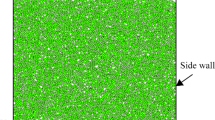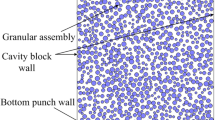Abstract
The internal mechanical behavior of powder system and the side wall friction behavior during powder compaction keep unclear yet. They are significant for revealing the densification behavior during powder compaction. The evolution of force chain quantitative characteristics (number, length, direction coefficient and buckling degree) and side wall friction characteristics (nominal friction coefficient, contact motion index and sliding work) at different compaction velocities, initial porosities and internal friction coefficients during ferrous powder compaction has been investigated by discrete element method. Results show that the small change in compaction velocity cannot influence the force chain characteristics and side wall friction behaviour. The different initial porosities and friction coefficients between particles can affect the force chain characteristics and the side wall friction behaviour. The force chain can be related to the side wall friction behaviour at different conditions, according to the corresponding characteristics of force chains and friction behaviour (before and after the axial strain reaches to 0.1). This study would expand the tribology of granular matter and is useful for understanding the internal and external mechanics during powder compaction.
Graphical abstract










Similar content being viewed by others
References
Staf, H., Kis, Z., Szentmiklósi, L., et al.: Determining the density distribution in cemented carbide powder compacts using 3D neutron imaging. Powder. Technol. 354, 584–590 (2019). https://doi.org/10.1016/j.powtec.2019.06.033
Nicewicz, P., Sano, T., Hogan, J.D.: Confined uniaxial compression of granular stainless steel 316. Powder. Technol. 353, 489–497 (2019). https://doi.org/10.1016/j.powtec.2019.05.041
Shin, D.S., Lee, C.H., Kim, S.H., et al.: Analysis of cold compaction for Fe-C, Fe-C-Cu powder design based on constitutive relation and artificial neural networks. Powder. Technol. 353, 330–344 (2019). https://doi.org/10.1016/j.powtec.2019.05.042
Chen, W.C., Wang, J.H., Wang, S.P., et al.: On the processing properties and friction behaviours during compaction of powder mixtures. Mater. Sci. Tech-Lond. 36, 1057–1064 (2020). https://doi.org/10.1080/02670836.2020.1747779
Zhou, M.C., Huang, S.Y., Lei, Y., et al.: Investigation on compaction behaviors of Ag35Cu32Zn33 mixed metal powders under cold die compaction. J. Adv. Mech. Des. Syst. 12, JAMDSM0037 (2018). https://doi.org/10.1299/jamdsm.2018jamdsm0037
Staf, H., Larsson, P.L.: Evaluation of an advanced powder-die frictional model. Powder. Technol. 363, 569–574 (2020). https://doi.org/10.1016/j.powtec.2020.01.048
de Gennes, P.G.: Granular matter: a tentative view. Rev. Mod. Phys. 71, S374-382 (1999). https://doi.org/10.1103/RevModPhys.71.S374
Zuo, P.C., Yu, H., Liu, J.L., et al.: Tensile and shearing behaviors of the particle raft. Acta. Mech. Sin. 37, 907–912 (2021). https://doi.org/10.1007/s10409-021-01081-3
Zhang, X.J., Sun, W., Wang, W., et al.: Experimental investigation of granular friction behaviors during reciprocating sliding. Friction (2021). https://doi.org/10.1007/s40544-021-0488-2
Meng, F.J., Liu, K., Qin, T.: Numerical analysis of multi-scale mechanical theory of densified powder compaction. J. Braz. Soc. Mech. Sci. 40, 430 (2018). https://doi.org/10.1007/s40430-018-1337-8
Wang, D.F., An, X.Z., Han, P., et al.: Particulate scale numerical investigation on the compaction of TiC-316L composite powders. Math. Probl. Eng. 2020, 5468076 (2020). https://doi.org/10.1155/2020/5468076
Zhang, W., Zhou, J., Zhang, X.J., et al.: Quantitative investigation into the relation between force chains and stress transmission during high-velocity compaction of powder. J. Korean. Phys. Soc. 74, 660–673 (2019). https://doi.org/10.3938/jkps.74.660
Olsson, E., Larsson, P.L.: A numerical analysis of cold powder compaction based on micromechanical experiments. Powder Technol. 243, 71–78 (2013). https://doi.org/10.1016/j.powtec.2013.03.040
Lei, Y., Yan, S., Huang, S., et al.: Experimental and numerical investigation of densification behaviors during powder compaction. J. Adv. Mech. Des. Syst. Manuf. 12, JAMDSM0022 (2018). https://doi.org/10.1299/jamdsm.2018jamdsm0022
Xu, R., Liu, E., Jiang, X., et al.: Analysis on evolution of mesostructure of cohesionless soil ground upon loading. Powder Technol. 368, 1–17 (2020). https://doi.org/10.1016/j.powtec.2020.04.048
Liu, J., Wautier, A., Bonelli, S., et al.: Macroscopic softening in granular materials from a mesoscale perspective. Int. J. Solids Struct. 193, 222–238 (2020). https://doi.org/10.1016/j.ijsolstr.2020.02.022
Itasca Consulting Group Inc: PFC2D (Particle Flow Code in 2 Dimensions). Itasca Consulting Inc, Minneapolis (1999)
Caserta, A.J., Navarro, H.A., Cabezas-Gómez, L.: Damping coefficient and contact duration relations for continuous nonlinear spring-dashpot contact model in DEM. Powder. Technol. 302, 462–479 (2016). https://doi.org/10.1016/j.powtec.2016.07.032
Berry, N., Zhang, Y., Haeri, S.: Lees-Edwards boundary conditions for the multi-sphere discrete element method. Powder Technol. 389, 292–308 (2021). https://doi.org/10.1016/j.powtec.2021.05.025
Jasion, G.T., Shrimpton, J.S., Li, Z., et al.: On the bridging mechanism in vibration controlled dispensing of pharmaceutical powders from a micro hopper. Powder Technol. 249, 24–37 (2013). https://doi.org/10.1016/j.powtec.2013.07.027
Govender, N.: Study on the effect of grain morphology on shear strength in granular materials via GPU based discrete element method simulations. Powder Technol. 387, 336–347 (2021). https://doi.org/10.1016/j.powtec.2021.04.038
Mehr, F.R., Salavati, M., Morgenthal, A., et al.: Computational analysis and experimental calibration of cold isostatic compaction of Mg-SiC nanocomposite powders. Mater. Today. Commun. 27, 102321 (2021). https://doi.org/10.1016/j.mtcomm.2021.102321
Jiang, M.J., Konrad, J.M., Leroueil, S.: An efficient technique for generating homogeneous specimens for DEM studies. Comput. Geotech. 30, 579–597 (2003). https://doi.org/10.1016/S0266-352X(03)00064-8
Garner, S., Strong, J., Zavaliangos, A.: Study of the die compaction of powders to high relative densities using the discrete element method. Powder Technol. 330, 357–370 (2018). https://doi.org/10.1016/j.powtec.2018.02.015
Meng, F.J., Liu, K.: Mechanical study on the effect of granular friction in a granular system under biaxial compression. J. Korean Phys. Soc. 72, 1179–1187 (2018). https://doi.org/10.3938/jkps.72.1179
Nie, Z., Qi, Q., Wang, X., et al.: DEM investigation of strain behaviour and force chain evolution of gravel–sand mixtures subjected to cyclic loading. Particuology 68, 13–28 (2022). https://doi.org/10.1016/J.PARTIC.2021.10.006
Liu, Y., Liu, H., Mao, H.: The influence of rolling resistance on the stress-dilatancy and fabric anisotropy of granular materials. Granul. Matter. 20, 12 (2018). https://doi.org/10.1007/s10035-017-0780-z
Mohamed, A., Gutierrez, M.: Comprehensive study of the effects of rolling resistance on the stress–strain and strain localization behavior of granular materials. Granul. Matter. 12, 527–541 (2010). https://doi.org/10.1007/s10035-010-0211-x
Kawakita, K., Lüdde, K.H.: Some considerations on powder compression equations. Powder. Technol. 4, 61–68 (1971). https://doi.org/10.1016/0032-5910(71)80001-3
Huang, P.Y.: Powder Metallurgy Principle. Metallurgical Industry Press, Beijing (2004)
Gerde, E., Marder, M.: Friction and fracture. Nature 413, 285–288 (2001). https://doi.org/10.1038/35095018
Azéma, E., Radjaï, F.: Force chains and contact network topology in sheared packings of elongated particles. Phys. Rev. E. 85, 031303 (2012). https://doi.org/10.1103/PhysRevE.85.031303
Sun, Q.C., Jin, F., Liu, J.G.: Understanding force chains in dense granular materials. Int. J. Mod. Phys. B. 24, 5743–5759 (2010). https://doi.org/10.1142/S0217979210055780
Iikawa, N., Bandi, M.M., Katsuragi, H.: Sensitivity of granular force chain orientation to disorder-induced metastable relaxation. Phys. Rev. Lett. 116, 128001 (2016). https://doi.org/10.1103/PhysRevLett.116.128001
Solimanjad, N., Larsson, R.: Die wall friction and influence of some process parameters on friction in iron powder compaction. Mater. Sci. Tech-Lond. 19, 1777–1782 (2003). https://doi.org/10.1179/026708303225009517
Alzouma, O.M., Robisson, A.C.: Die wall lubrication for UO2 pellets pressing: a case study. Ceram. Int. 44, 15905–15911 (2018). https://doi.org/10.1016/j.ceramint.2018.06.007
Acknowledgements
This work was supported by the Natural Science Foundation of Fujian Province (Grants No. 2020J01869 and 2020J01874) and the Initial Scientific Research Fund in Fujian University of Technology (Grant No. GY-Z19123). The first author specifically thanks his lover, Dr. Rongxin Chen.
Author information
Authors and Affiliations
Corresponding author
Ethics declarations
Conflict of interest
The authors have no competing interests to declare that are relevant to the content of this article.
Additional information
Publisher's Note
Springer Nature remains neutral with regard to jurisdictional claims in published maps and institutional affiliations.
Rights and permissions
About this article
Cite this article
Zhang, W., Zhang, S., Tan, J. et al. Relation between force chain quantitative characteristics and side wall friction behaviour during ferrous powder compaction. Granular Matter 24, 86 (2022). https://doi.org/10.1007/s10035-022-01244-4
Received:
Accepted:
Published:
DOI: https://doi.org/10.1007/s10035-022-01244-4




